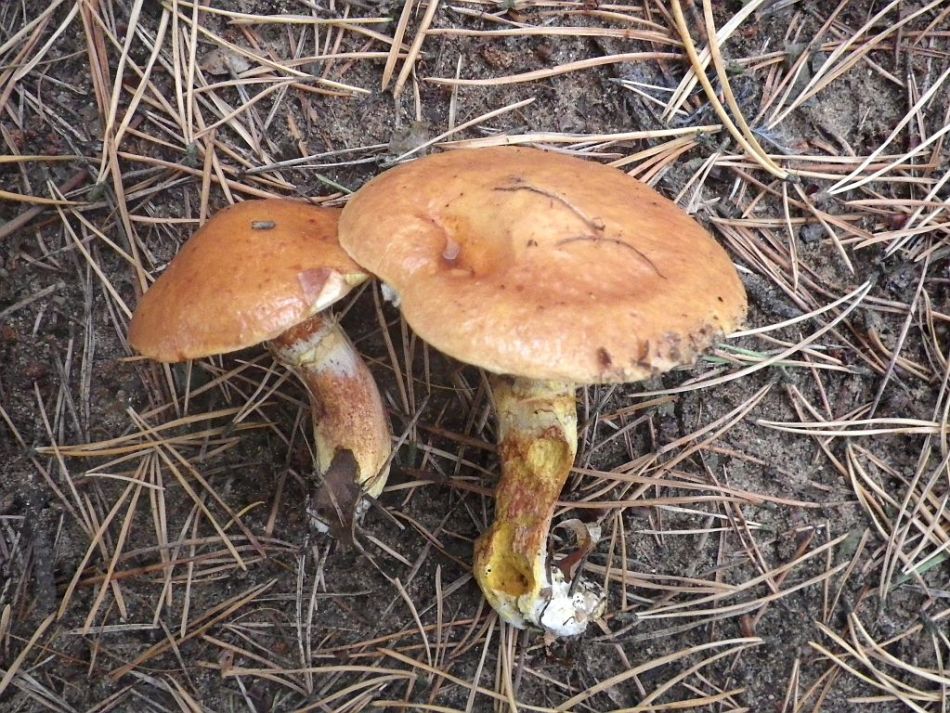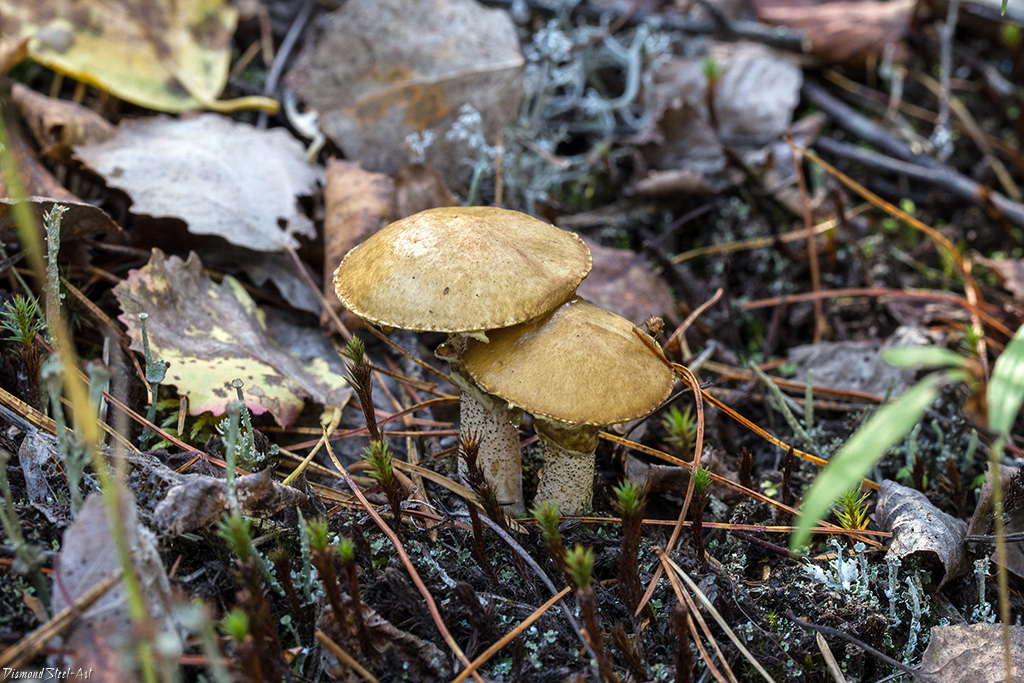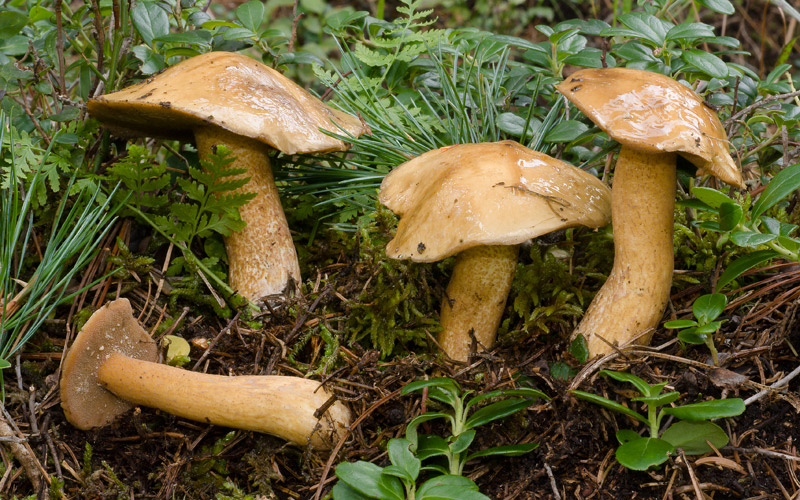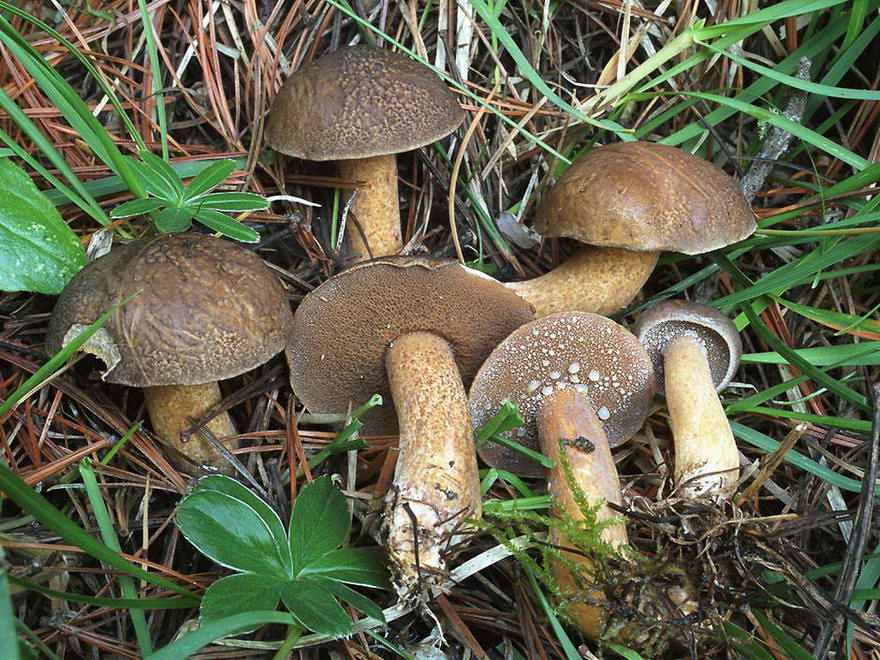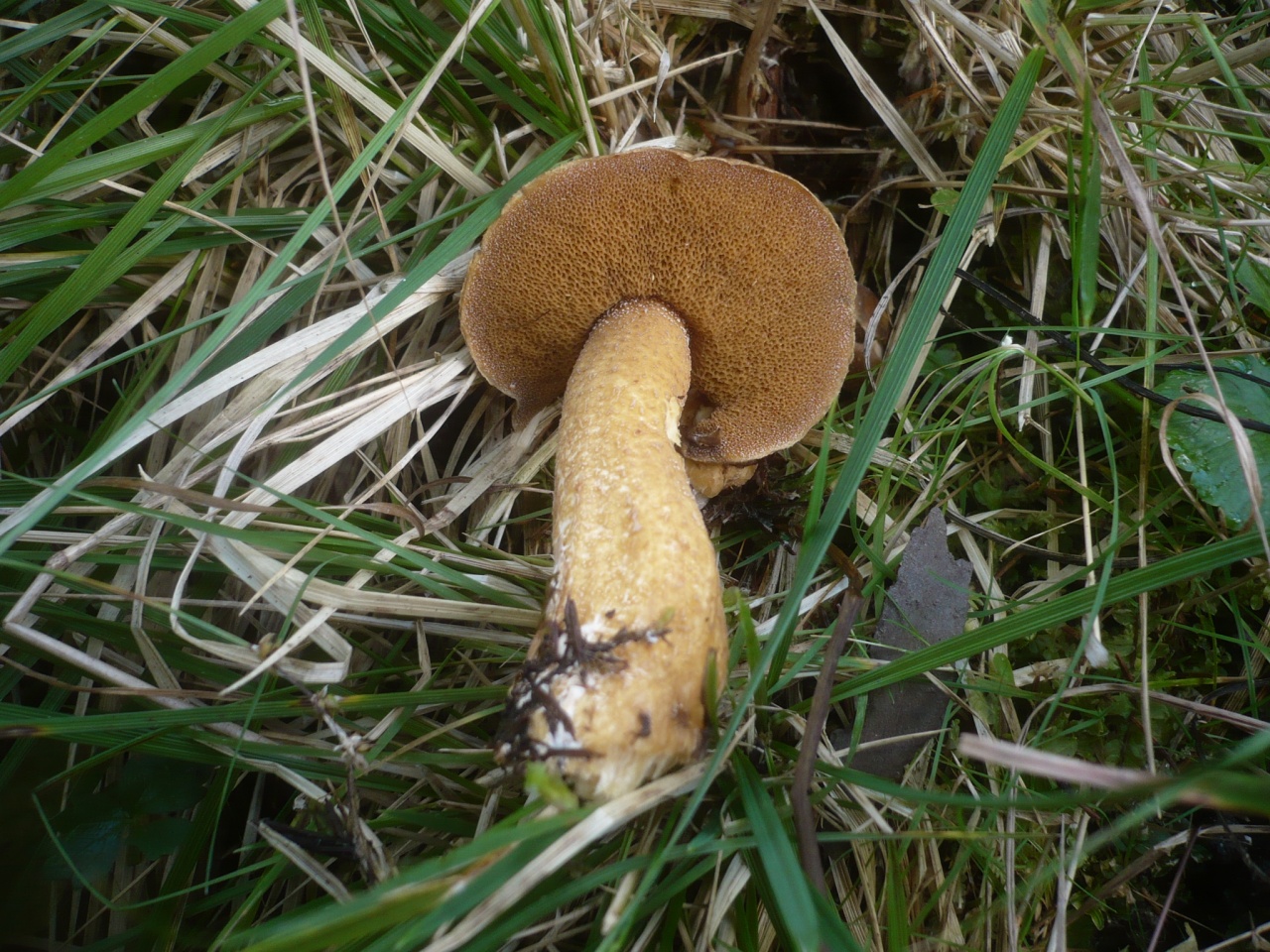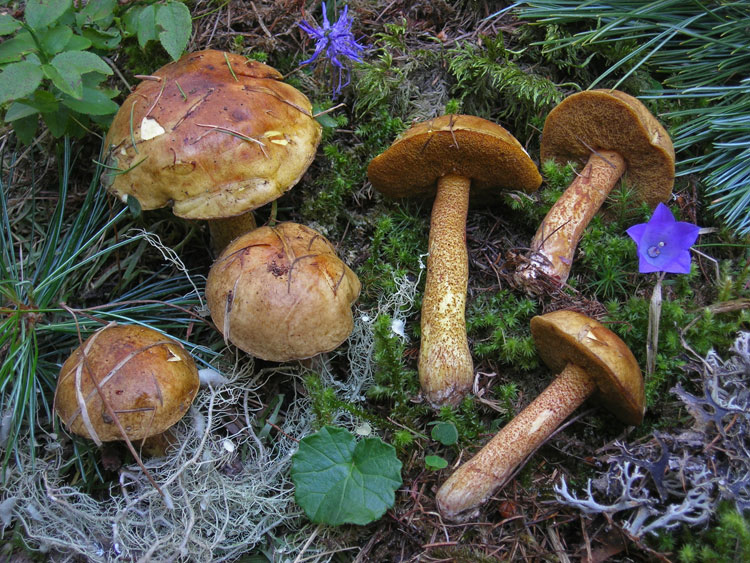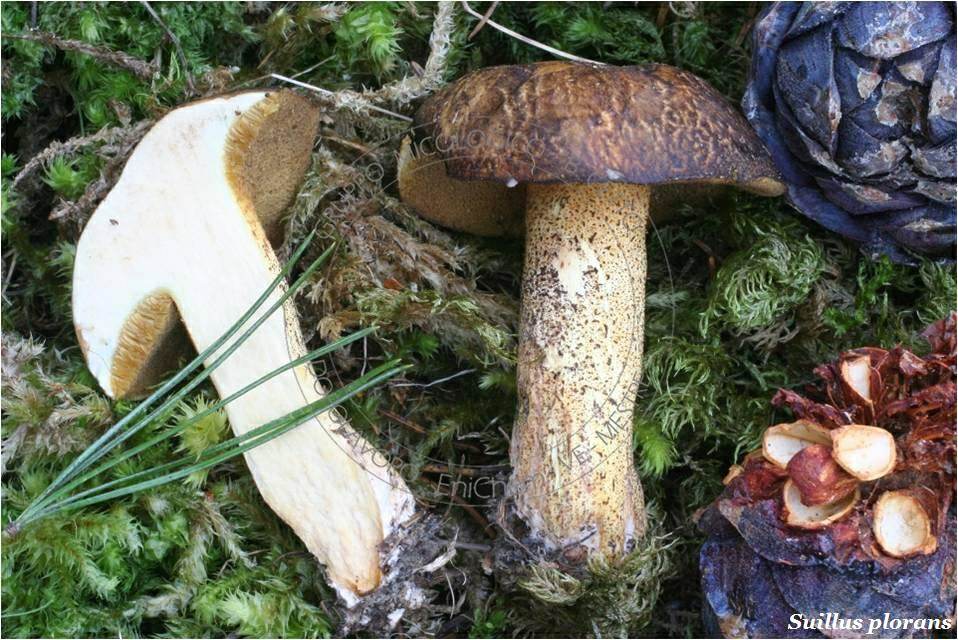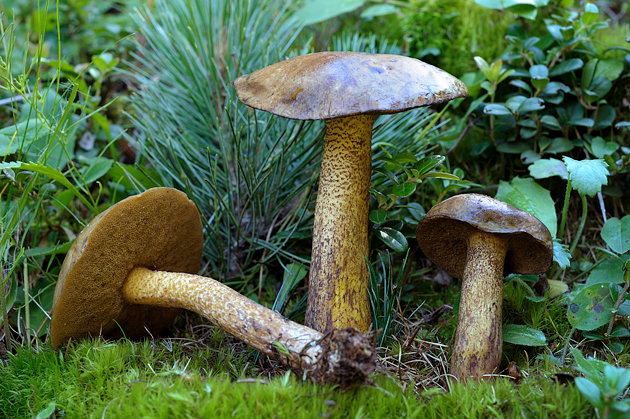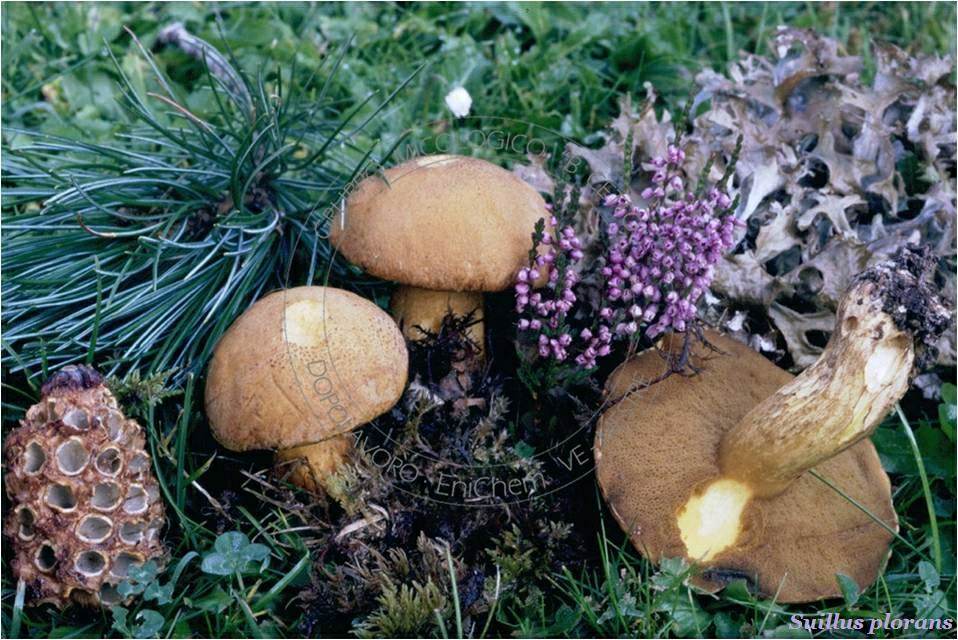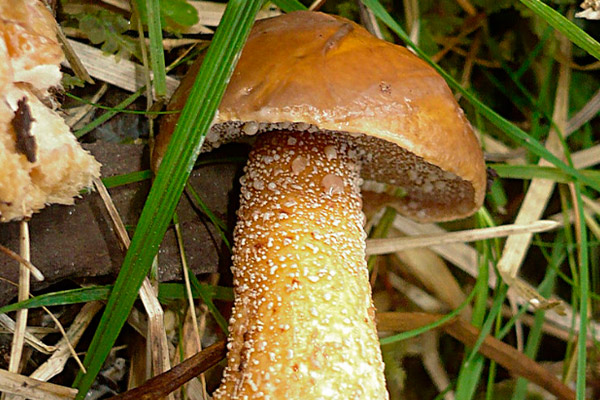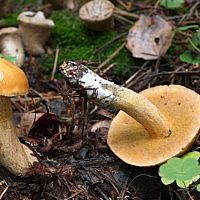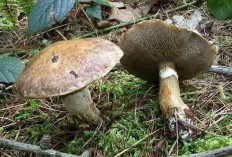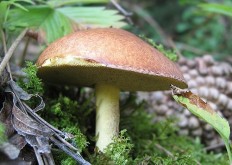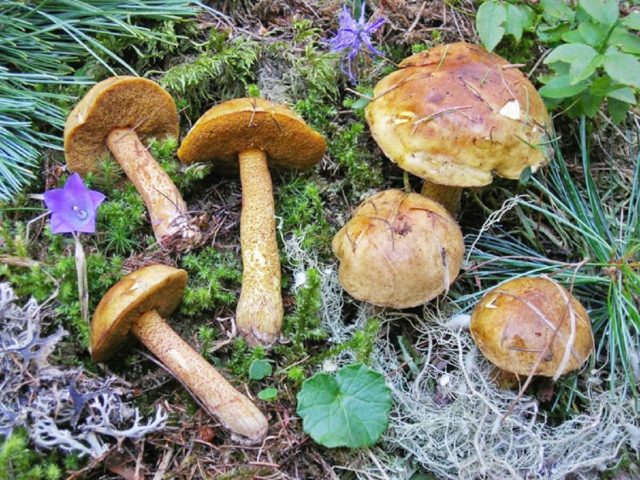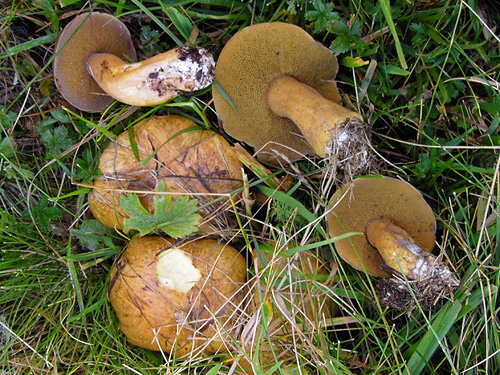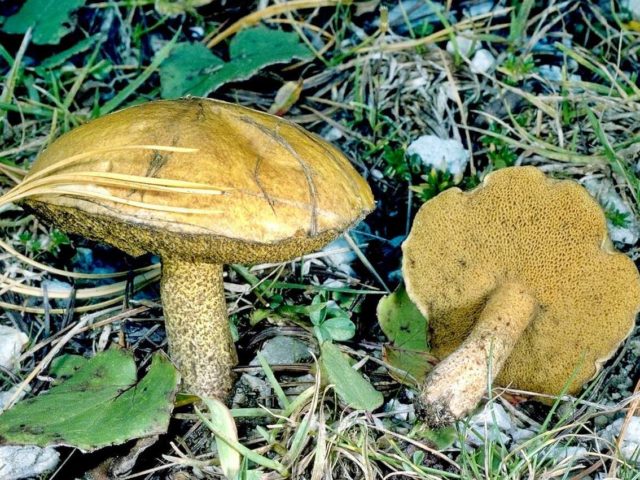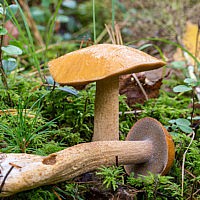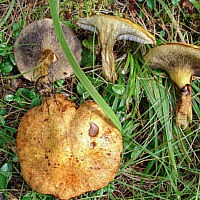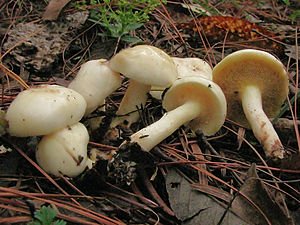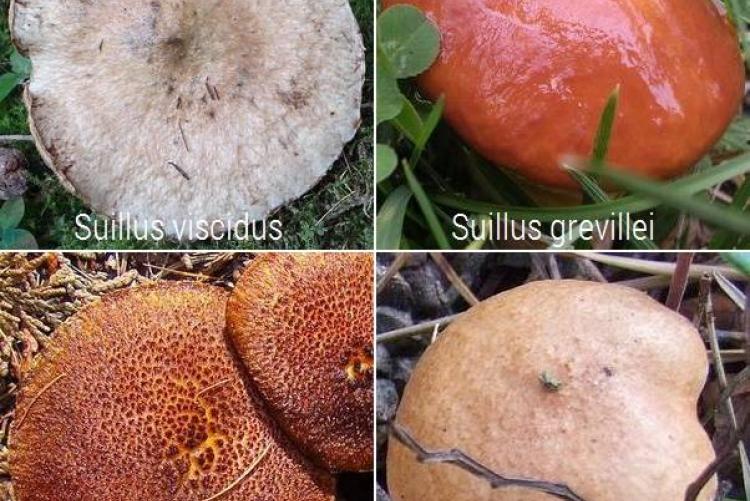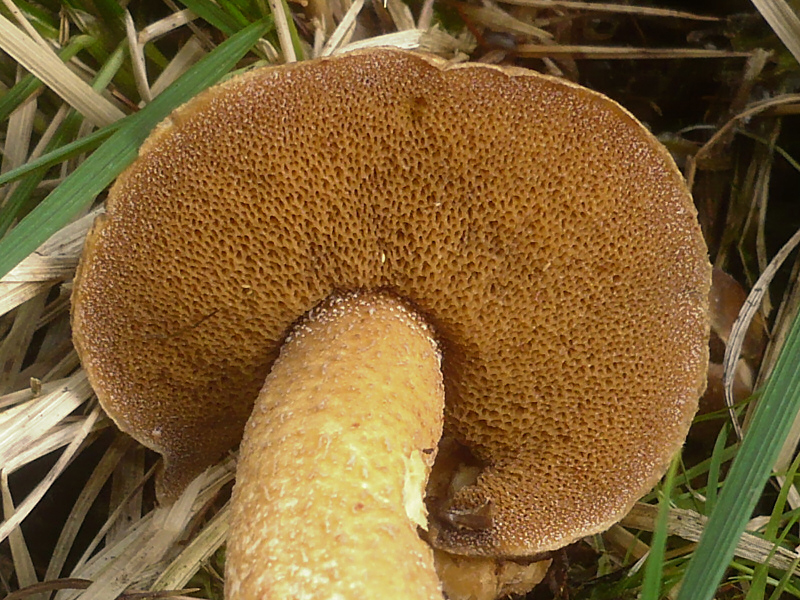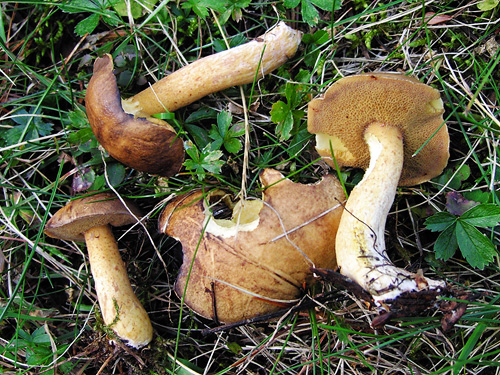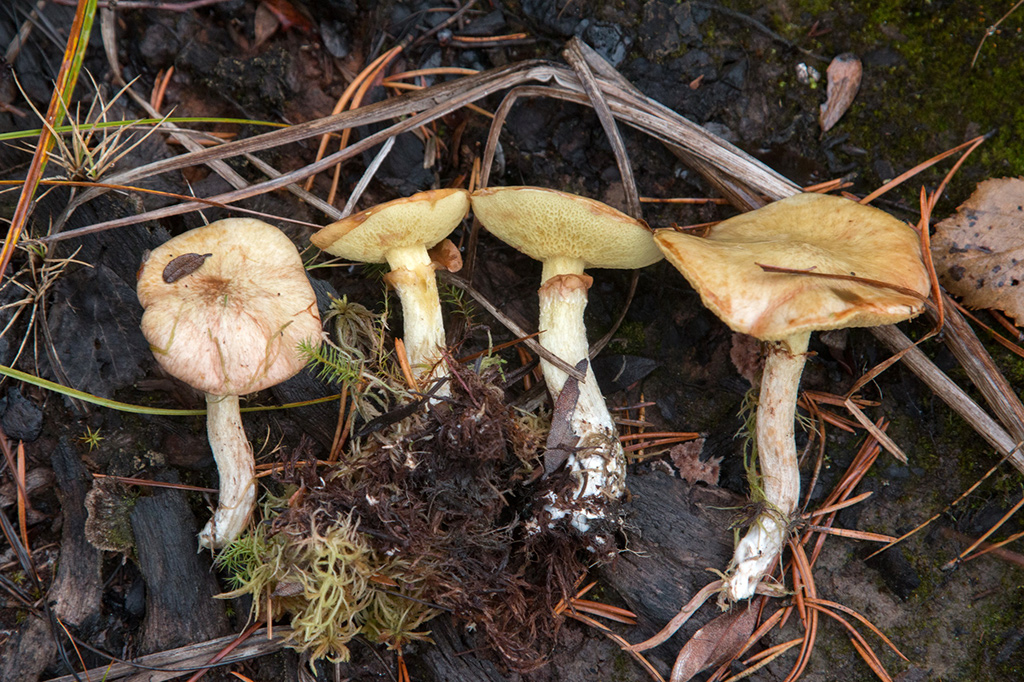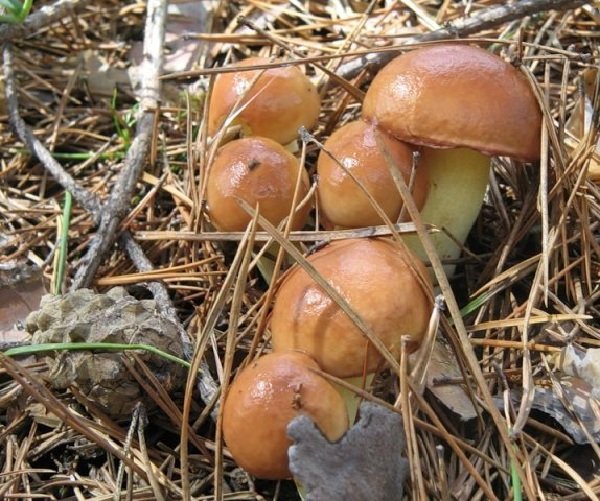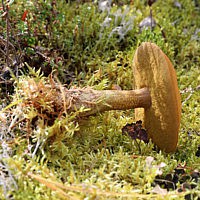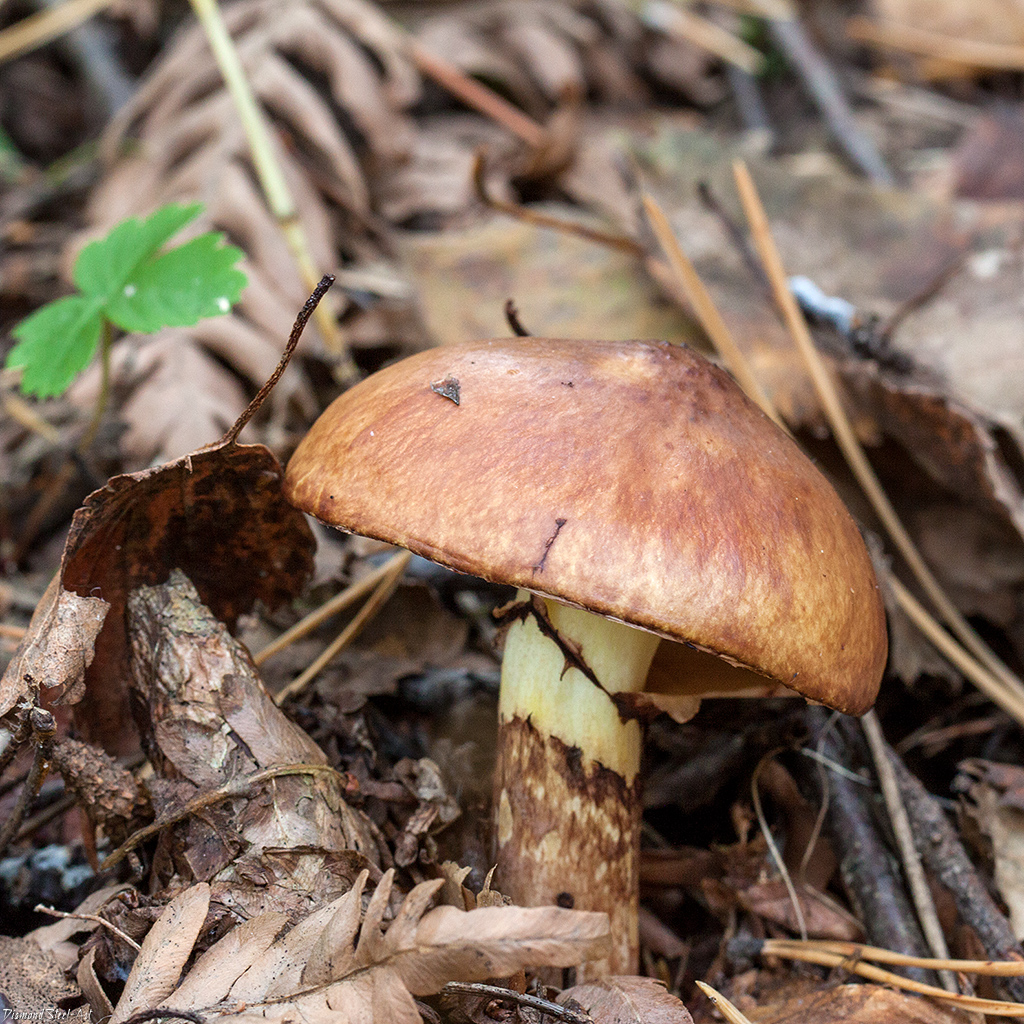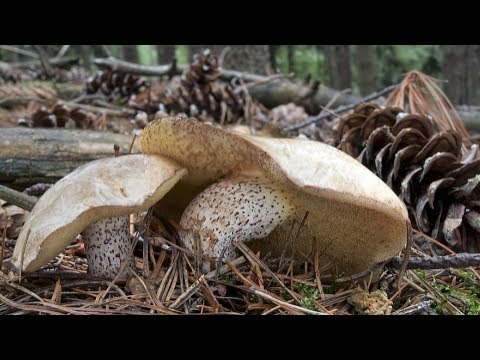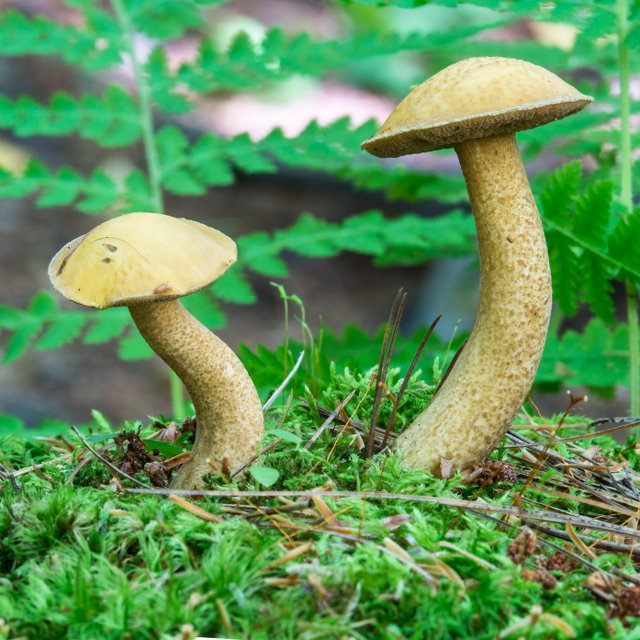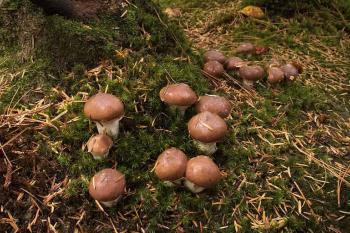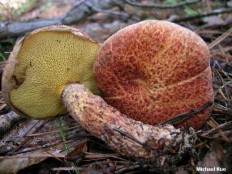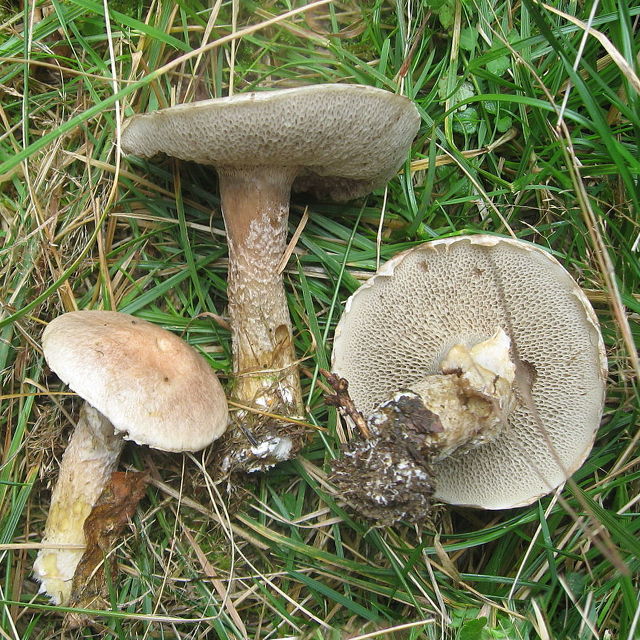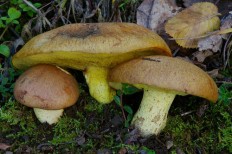Granular oiler
Granular butter dish (Suillus granulatus)
Granular butter dish (Suillus granulatus)
This mushroom is also called a summer oil can, an early oil can. Its usual habitat is thinned pine forests, young plantings, clearings, glades, edges. It can be found in coniferous forests, with the presence of pine. Loves sandy and calcareous soils. A fairly common mushroom.
The cap of a granular oiler reaches up to 10 cm in size, in mature mushrooms. At an early age, its shape has a rounded-convex, pillow-like shape. Over time, as it grows, it straightens out, and becomes almost flat in adulthood. The color of the skin of the cap of a granular oiler varies from yellow-brown to chestnut or red-brown. The skin is smooth, mucous to the touch in rainy or wet weather. It becomes shiny in dry weather. The skin is thin and easily removed from the cap. The pulp is elastic, soft. On the cut, it is first white, over time the color changes and turns slightly yellow. Almost odorless.
Tubular layer adhered to the cap. The tubules are short, finely porous. At a young age, light yellow in color, over time they become dirty yellow, sometimes with a greenish tinge. In damp weather, droplets of a white, sticky liquid are released. The pores are light yellow, roundish, small. Over time, the color changes to a dirty yellow. The size and shape are also changing. The pores become larger (sometimes up to 1 mm) and uneven.
A characteristic feature of a granular oiler is the absence of a ring on its stem. The leg is solid, cylindrical, smooth, falling, white liquid from the tubular layer falls on the leg and dries there, forming brown granularity in its upper part. Stem sizes can reach 6-8 cm in mature mushrooms. The color changes from light yellow at an early age to yellow-brown in old age. The pulp is firm, white or light yellow in color. When cut, as a rule, the color does not change. Granular oiler belongs to the second category of mushrooms. Usually grows in small groups. In rare cases, singly. You can recognize it by the peculiar graininess in the upper part of the leg and the absence of a ring on it, as well as by the liquid released in the lower part of the cap. The growing season is early summer (June) and until November. It is used in food in any form. A very tasty and healthy mushroom.
Oiler gray
Butter dish gray - lat suillus aeruginascens
In another way, this mushroom is called the Gray Larch Butter, the Tubular Gray Larch or the Blue Butter.
Description
Mushroom cap
The gray larch oiler has a cushion-shaped, often lumpy hat, reaching 5-12 cm in diameter. It is covered with poorly lagging smooth moist sticky skin covered with brownish scales. It often contains flocculent particles of a torn blanket covering the tubular layer.
The skin is usually dyed pale gray, often shaded with brownish, purple or olive shades.
The inside of the hats contains a white, loose flesh, which eventually turns into a dirty white or brownish. When cut, it quickly becomes bluish.
The hat bottom is formed by a brownish-gray, gray-yellow, gray or grayish-white tubular mass of wide tubes running down the legs, having an irregularly angular shape.
The gray tubular larch reproduces by smooth, elongated brownish spores that form in a brown spore powder.
Stipe
The gray oiler has a high leg that grows up to 1-3.5 cm in thickness and 5-9.5 cm in length. It is located in the middle of the hat, in the form of a straight or curving cylinder filled with a pale yellow dense pulp.
The stem is colored yellowish, pale gray or brownish with purple or olive notes. From the bedspread, a wide felt ring of white color remains on it, which disappears as the oil matures.
Growing places
The blue oiler prefers young larch or pine young stands with sourish soil, in which it grows in large families, sometimes one mushroom is found.
Fruiting begins in June and ends at the end of October.
Edibility
Having, though not saturated, but an appetizing aroma and pleasant taste, the Gray Butter belongs to the edible mushrooms of the third category. It is boiled, stewed, fried, used for pickling, be sure to remove the skin (otherwise you can get diarrhea). If you cannot remove it from the cap, immerse the fungus in boiling water for a couple of minutes.
The nutritional value of gray butter is equivalent to the nutritional value of porcini mushrooms. In terms of the rich content of amino acids, Blue Butter is equated to meat, and a large amount of vitamin PP makes mushrooms no less useful than liver or fish. By the way, it is not grown-up but young boletus that are most useful.
Distribution locations and collection times
The excellent taste and fleshy appetizing structure, as well as the aromatic sticky juice that stands out, attract many insects, and it can be difficult to harvest the whole fruiting bodies of these mushrooms. Therefore, you need to notice the growing places and get up early in order to have time to collect a whole basket at morning dawn. Connoisseurs especially appreciate the fall harvest when insect activity is minimal.
Summer oil can grow in colonies in coniferous forests, forming mycorrhiza with different types of pine. This species is found in the period from June to October on sandy soils, in sparse plantings and clearings, in open glades and along roads.
Larch boletus live under slender larch trees of different species, it is with these trees that they form mycorrhiza and grow only where there is a root system of this species. Harvested from early summer to late autumn.
Late oiler grows in numerous groups under pine trees on sandy loam soils. They find it under fallen needles and among the grass in deciduous-coniferous forests. Most often it grows in open areas - near roads, and glades in clearings and forest edges.
Among the swampy pine forests, on the hills, yellowish bog boletus grows, they are collected in late summer and early autumn.
In sunny forests near pines and cedars, cedar boletus grows, which most willingly settle among young growth or in clearings. The first harvest coincides with the flowering of the pine, and fruiting lasts in waves until the beginning of autumn
Cut the rare mushroom carefully, preserving the mycelium and sprinkling it with foliage
Greyish oiler appears under the pines and larch trees, most often forming mycorrhiza with larch. Fruiting bodies are harvested from July to September-October.
White boletus grows under the cedars and pines, singly and in small groups of 3-5 specimens. The best harvests are harvested in late summer and early autumn.
Ordinary butter dish
Common butter dish (Suillus luteus)
Common butter dish (Suillus luteus)
It is also popularly called late oiler, yellow oiler, real oiler, autumn oiler.
One of the most common and beloved mushrooms. Grows in pine forests, in young stands. Found in mixed pine-birch and pine-oak forests. In relation to light, it is not whimsical, it can grow both in darkened areas of the forest, and on the edges of the forest, in small bright glades, along the sides of roads. You can find it, as a rule, under fallen pine needles or leaves. Prefers sandy soil. In highly humid places, in swamps, near lakes or peat bogs, the common oiler does not grow.
The hat is 5-12 cm. There are also large sizes. At first it has a rounded, hemispherical shape. The cap of an ordinary oiler is painted in a dirty yellow or brownish color. Over time, the cap straightens out, and becomes flat-convex and finally, almost completely flat. When ripe, the color of the cap also changes. It turns dark brown, chocolate brown. Sometimes reddish brown or reddish brown. To the touch, the cap is smooth, covered with mucus. The skin covering the body of the cap is easily peeled off. The pulp is firm, but soft, fleshy. White or slightly yellowish.The tubular layer adhered to the stem is at first light, then turns yellow, and in mature mushrooms it is olive yellow. The pores are round, small.
The leg of an ordinary oiler is short. Reaches a length of 4-9 cm (sometimes up to 12). It has a cylindrical shape. The pulp of the leg is fibrous, solid. In young butter, the edges of the cap are connected to the stem by a thin, white film. As it grows, the cap straightens, the film breaks, as a result of which a light ring forms on the stem. Above the ring, the leg is white. The rest is colored yellow or off-yellow.
The growing season for this mushroom lasts from mid-summer until the first autumn frosts. As soon as the temperature drops and becomes minus on the surface of the soil, the ordinary oiler stops bearing fruit. Massively begins to bear fruit in the month of September. It usually appears on the second or third day after rain. The optimum temperature for fruiting is 15-20 degrees. He loves friendly companies, so he grows in groups. Does not reject neighbors such as chanterelles, porcini mushrooms, russula. In the summer, it is especially susceptible to damage by pests (worms, insect larvae). Therefore, in the summer, you should not wait for its ripening. It is possible and even necessary to collect them at a young age, when the hat has not yet opened. At this age, ordinary oiler is considered the most delicious.
But, in spite of this, the ordinary oiler is one of the most common and everyone's favorite mushrooms. In some countries, they are engaged in artificial breeding of these boletus.
Oiler ordinary photo
Butter dish (Suillus luteus) Butter dish (Suillus luteus) Butter dish (Suillus luteus)
Yellowish butter dish
Butter dish yellowish - Latin Suillus salmonicolor
In another way, the mushroom is called the Swamp Butter or Yellowish Bolet.
Description
Mushroom cap
The swamp oiler has a small cap, the diameter of which reaches 30-60 mm, and only occasionally - 100 mm. In young mushrooms, the "headgear" looks like a ball or hemisphere, the hat of an adult mushroom opens completely or turns into a pillow, sometimes with a tubercle in the middle.
The hats are covered with a skin that easily falls behind them when cleaning. It is colored in yellow - ocher, yellow - gray, brown - yellow, ocher - yellow or chocolate tone. Occasionally, the hat color is shaded with lilac or purple. When it is dry, the skin remains simply sticky, in rainy season it becomes covered with mucus and becomes slippery. Hat edges often retain jelly-like traces of bedspreads.
Hat bottoms are filled with a tubular layer of yellow-ocher or other yellowish shade, eventually darkening to brown. The tubular mass grows to the stem or descends slightly along it.
The yellowish oiler's hat fills with white or pale yellow flesh. In the area of the leg and under the skin, the pulp is bright yellow or reddish yellow, and sometimes light brown.
These boletus are propagated by fusiform smooth yellowish spores, which are in the same color spore powder.
Stipe
The mushroom legs, which are characterized by the shape of a curved cylinder, grow about 4-8 cm long and 30-50 mm thick. The leg is located in the center of the cap and is completely filled with white or pale yellow pulp. Its surface is smooth and painted in a yellowish color, above the ringlet - in a white tone.
On the legs there are brownish or dirty yellow oily rings of white color, becoming lilac or purple with age. In young fungi, rings form sticky white blankets that cover the spore-bearing layer. As it grows, the coverlet breaks, leaving pieces on the caps, and the ringlet remains on the stems.
Places of growth and fruiting
The marsh oiler prefers to develop and bear fruit in a warm climate and on sandy soil in a damp and even swampy mixed forest with birch and pine trees. Often found near pine trees, both old and young.
Fruiting occurs in large and small groups, as well as singly, and occurs in August - September. In regions with warmer climates, the mushroom produces bountiful harvests from late May to late November.
Edibility
Due to the tasty pulp that does not contain toxic substances, this type of butter is widely used in cooking, as it is a conditionally edible mushroom. The main thing is to remove the sticky skin from the caps: if you eat mushrooms without removing the skin, you can "earn" prolonged diarrhea.
Since yellowish boletus is eaten with pleasure not only by humans, but also by insects and their larvae, it is important to have time to collect them while they are very young. Adult mushrooms are not worth picking: they are completely eaten away by worms
The yellowish butter dish is very similar to the Siberian butter dish - an edible mushroom that does not have a jelly-like ring and the remains of a blanket on the edges of hats. In addition, the twin prefers coniferous forests with cedar trees.
Taste qualities of Siberian butter
Siberian boletus is an edible and tasty mushroom.

Other mushrooms of this genus
Cedar Butter is an edible mushroom. The diameter of the cedar oil can is 3-15 centimeters. Its shape is at first hemispherical, and eventually becomes cushion-shaped. The surface of the cap is brown. In dry weather, it is waxy and fibrous, and in wet weather it becomes greasy. The height of the leg is 4-12 centimeters, and the thickness is 1-2.5 centimeters, the leg tapers upwards. Its color is ocher brown, milk drops appear on the surface.
From the name it is clear that cedar boletus grows in coniferous and cedar groves. They bear fruit better in new plantings, among small shoots. These mushrooms are common in Siberia. They bear fruit from August to September.
Butterdish is yellow-brown, it is marsh, variegated, sandy, pestle and marsh - an edible mushroom. His cap is initially semicircular in shape with a curved edge, over time it changes to a cushion. Its diameter ranges from 5 to 14 centimeters. The color of the cap is gray-orange, olive, brown-red and light ocher. At first, the cap is pubescent, and with age it cracks into small scales. The leg is clavate or cylindrical, 2-3.5 centimeters thick and 3-9 centimeters high. The surface of the leg is smooth, lemon-yellow, the lower part is orange-brown or reddish.

Yellow-brown boletus grows on sandy soil. They bear fruit from June to November. Found in mixed and coniferous forests. They can often be found in large quantities. These mushrooms are common in Europe and Russia. By their taste they were assigned the 3rd category.
Butter - description, appearance, photo. What do boletus look like?
Hat.
Butter mushrooms are small and medium-sized mushrooms, some species are similar to mushrooms. The cap of young mushrooms has a hemispherical, sometimes conical shape. As it grows, it straightens out and, as a rule, takes a pillow-like shape. The largest diameter of the cap is 15 cm.
A feature of butter, which distinguishes them from other mushrooms, is a thin film-skin covering the cap: glutinous and shiny. It can be slimy, constantly or only during wet weather, and in some species it is slightly velvety, subsequently cracking into small scales. The skin is usually easy to separate from the pulp. Its colors range from yellow, ocher tones to brown-chocolate and brown, sometimes with spots and color transitions. The color of the cap depends not only on the type of oiler, but also on the light and the type of forest in which it grows.
Hymenophore.
Hymenophore (spore-bearing layer) tubular oil. The tubules, mostly adherent, of light yellow tones, become darker as the fungus ages. The mouths of the tubules, or pores, are generally round and small.
Pulp.
The pulp is dense, but soft. Its color is whitish or yellowish; on the cut, in some types of butter, it can change: redden or turn blue. The pulp does not smell at all or has a pleasant coniferous smell. Butterlets age very quickly. After 7-9 days, the pulp becomes flabby and dark. In addition, these fungi often infect worms.Not only old, but also very young, mushrooms that have just come out of the ground are exposed to the invasion of worms, among which one out of fifteen turns out to be not wormy.
Leg.
The leg of the oil is cylindrical in shape. Its average size is 1 to 3.5 cm in diameter and 4 to 10 cm in height. The color is whitish with a dark bottom or matches the color of the cap. It happens that a whitish liquid is released from the pores and solidifies in droplets on the stem, while its surface becomes granular.
Bedspread and spore powder.
In some varieties of butter, there is a blanket connecting them between the cap and the leg. When the mushroom grows, it bursts, leaving a ring on the stem. In this case, scraps of film may also remain at the ends of the cap. Spore powder oil has various shades of yellow.
Types of butter
The genus Oiler unites about 50 species of mushrooms.
In view of the peculiarities of morphology, some taxonomists classify the genus of boletus (Suillus) to the family of moss (lat.Gomphidiaceae), or altogether separate it into a separate family of Suillaceae.
Below, for convenience, I have divided the types of butter into 3 categories, depending on the edibility.
Edible species:
Oiler ordinary, oily can late, oily can yellow, oily can, autumn oily (Suillus luteus).
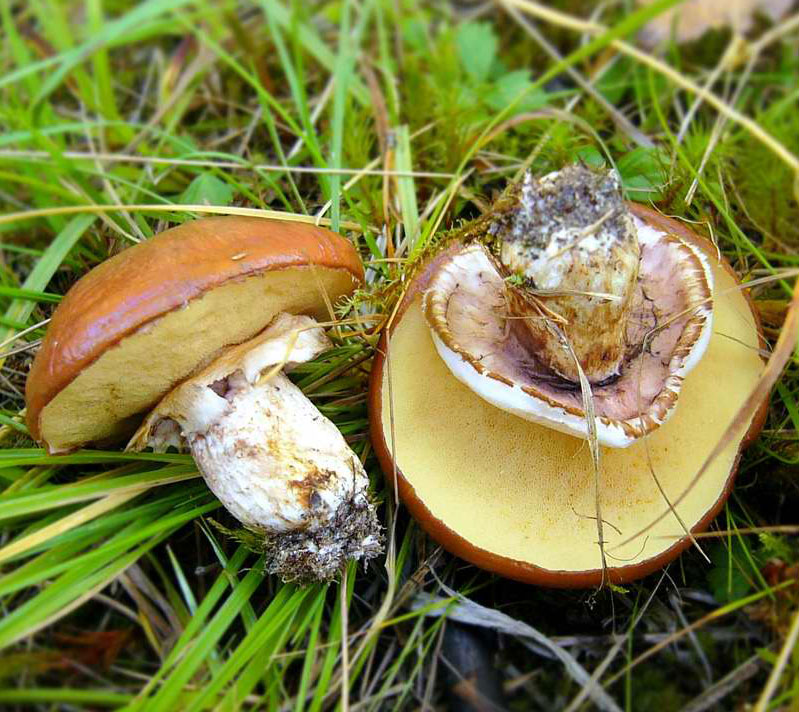

Bellini butter dish (Suillus bellinii).


Belted butter dish (Suillus clintonianus).
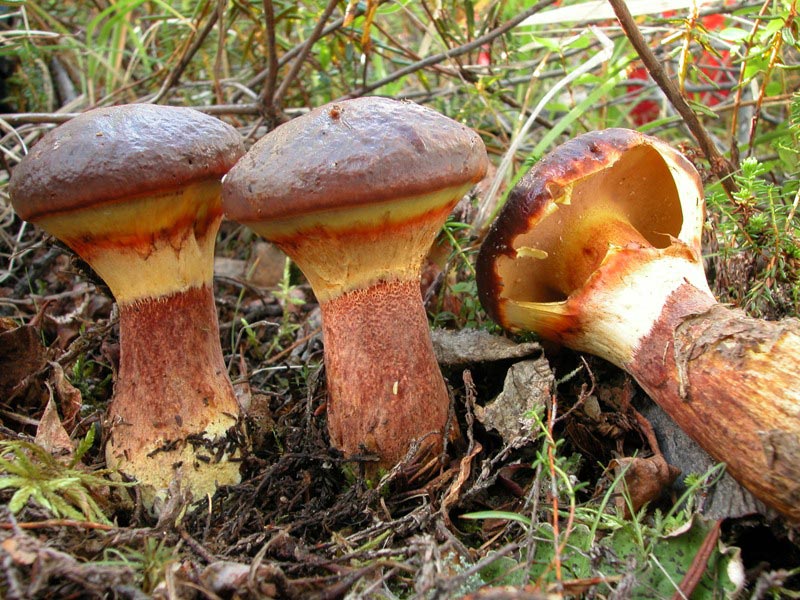
Butter dish is marsh, butter dish yellowish (Suillus flavidus).
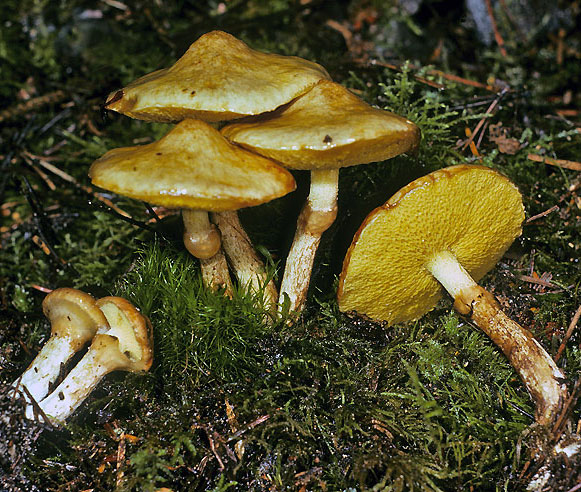
Granular butter dish, summer butter dish (Suillus granulatus).
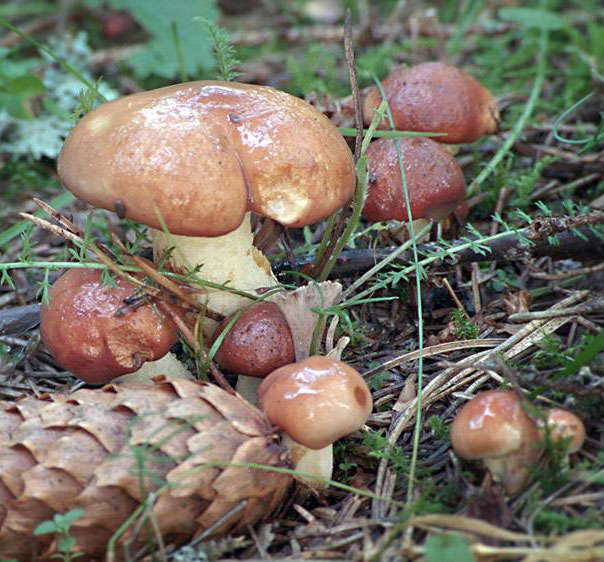
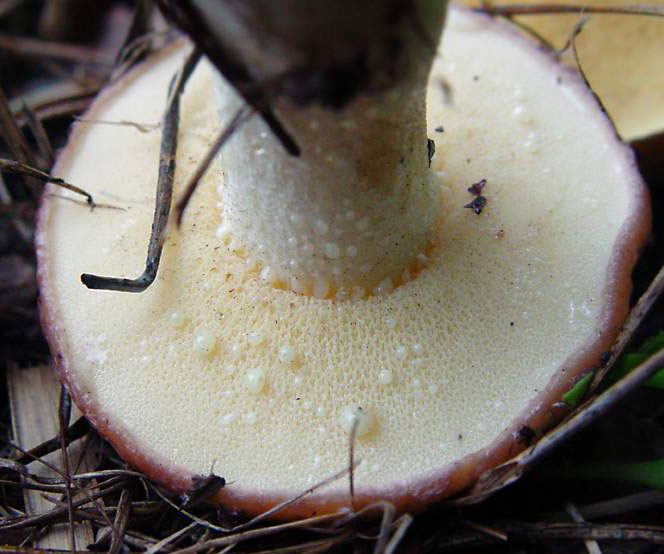
Butter dish is white, butter dish is pale, butter dish is soft (Suillus placidus).

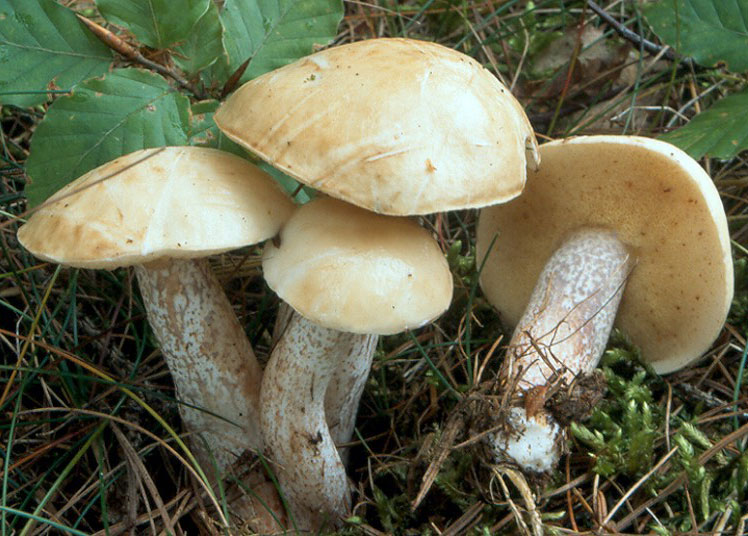
Cedar butter dish (Suillus plorans).
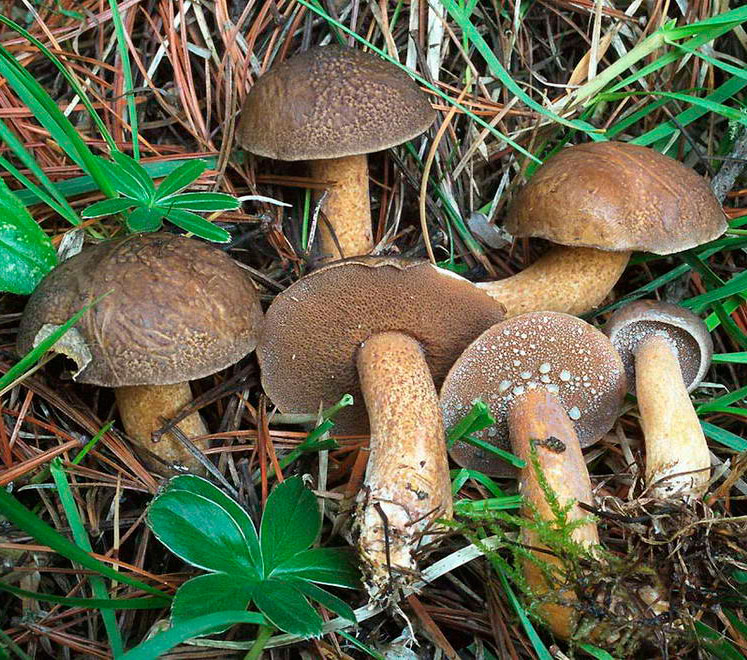
Ruby butter dish (Suillus rubinus).
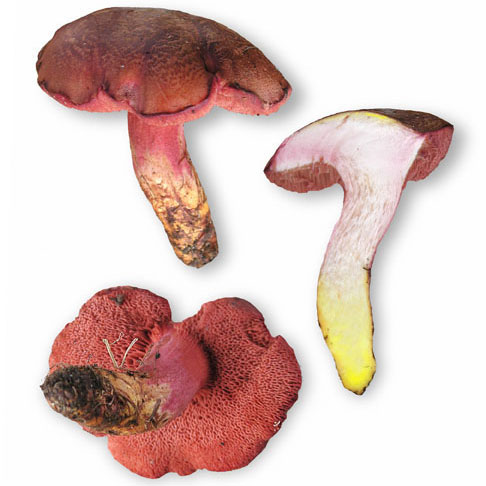
Butter can red-red (Suillus tridentinus).

Butter dish yellow-brown, swamp butter dish (Suillus variegatus).
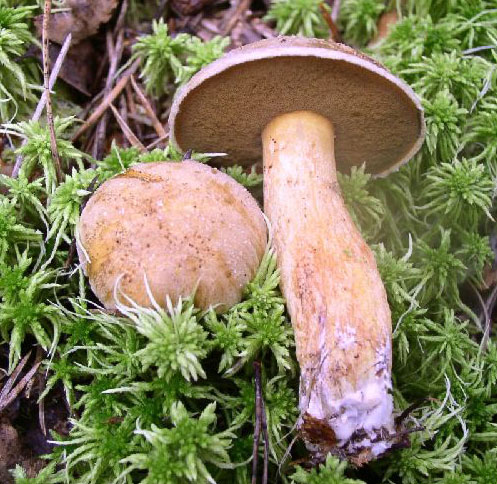
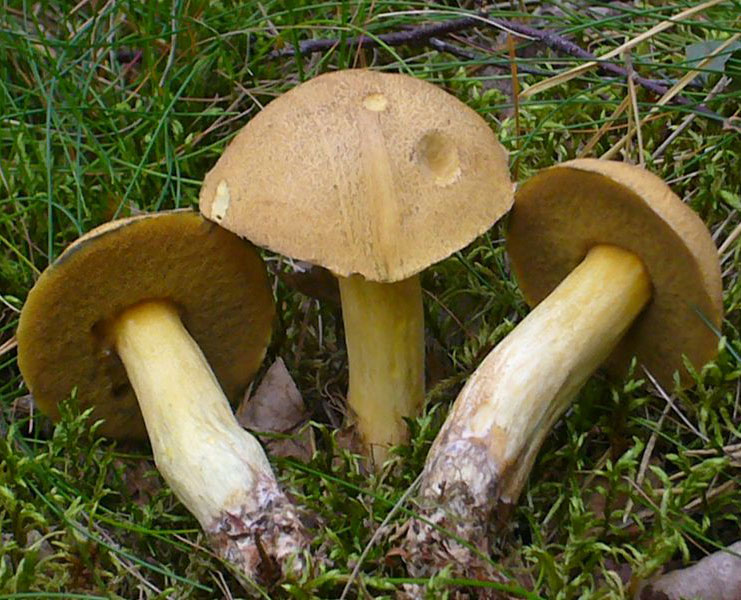
Conditionally edible species
Larch Butter (Suillus grevillei (Suillus elegans)).
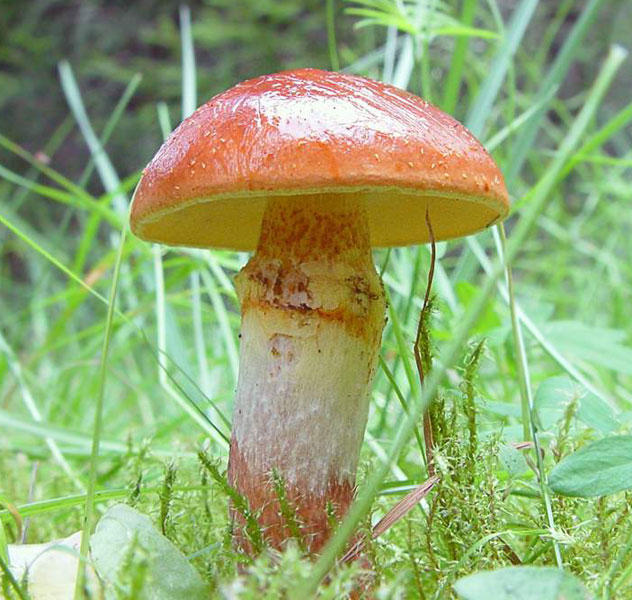
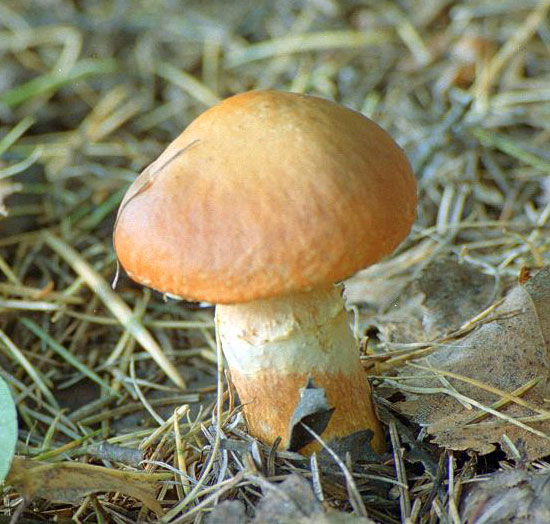
Greyish oiler, blue larch oiler (Suillus aeruginascens).
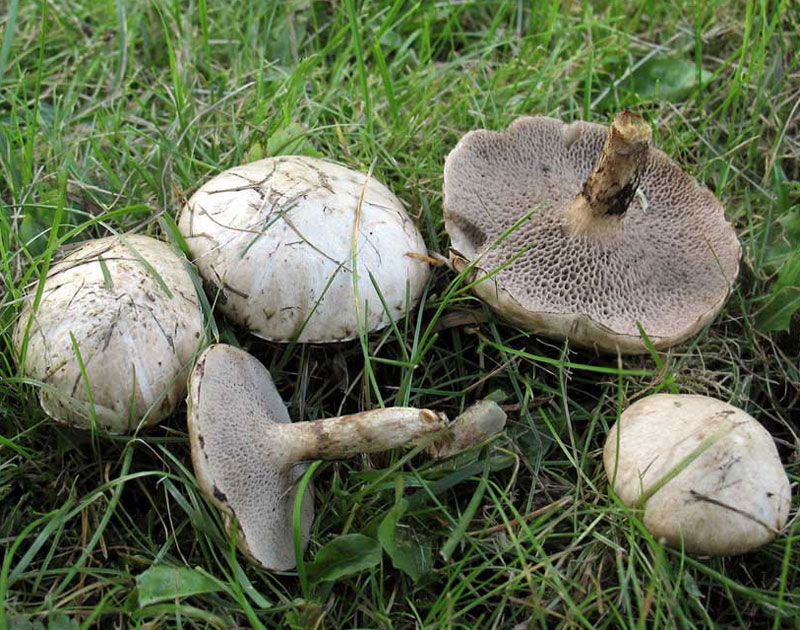
Goat, sieve (Suillus bovinus).
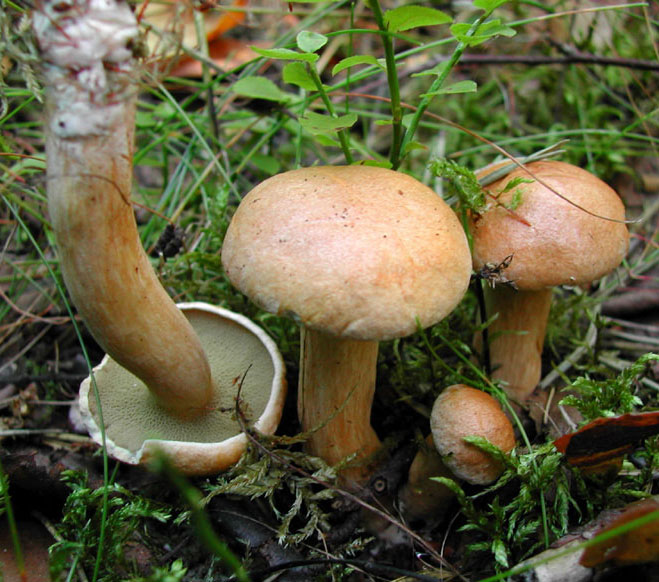
Yellowish butter dish (Suillus salmonicolor).
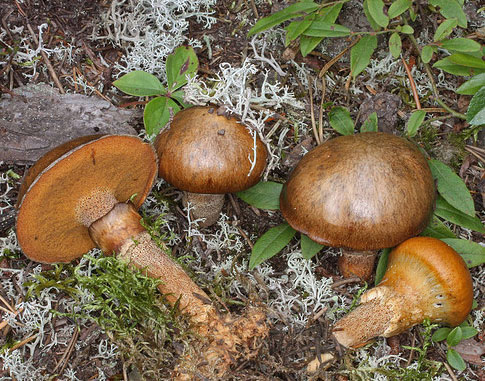
Inedible species
Peppercorn, pepper mushroom (Suillus piperatus).

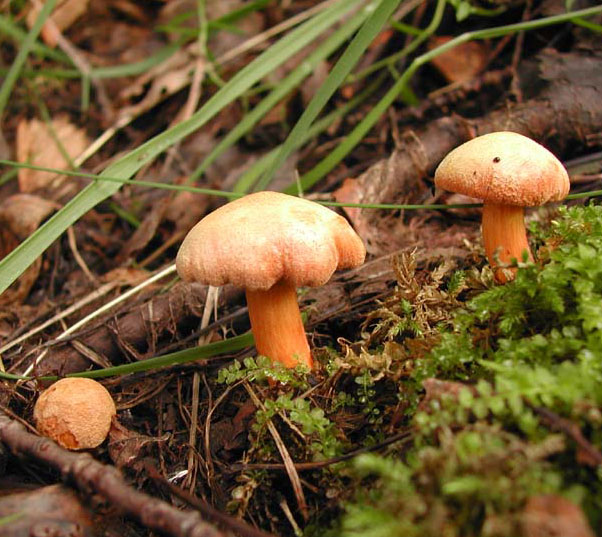
Siberian butter dish (Suillus sibiricus).
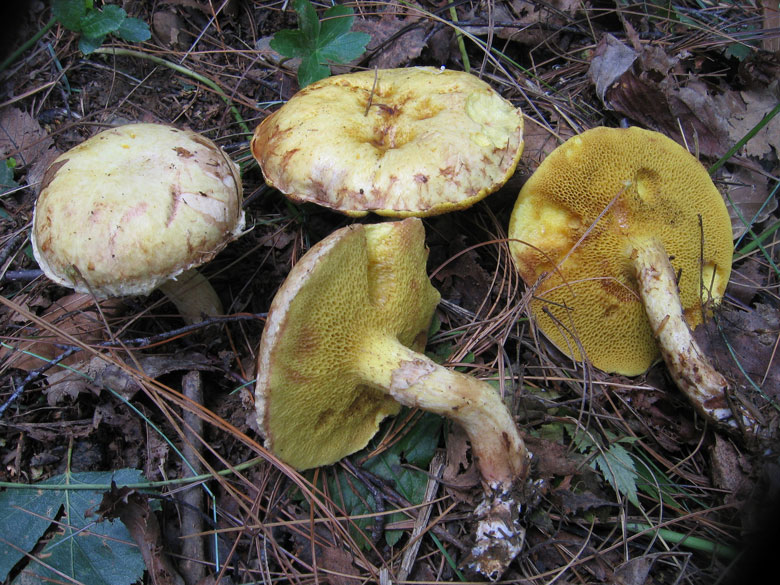
Notable butter dish (Suillus spectabilis).

Crying cedar butter dish (Suillus plorans) - Mushrooms of Siberia

Current title
| Index Fungorum | Suillus plorans (Rolland) Kuntze |
| MycoBank | Suillus plorans (Rolland) Kuntze |
Systematic position
Fungi, Basidiomycota, Agaricomycetes, Boletales, Suillaceae, Suillus
Etymology of the species epithet
Ploro, lat. weep bitterly, weep desperately, weep for someone.
Synonyms
- Boletus plorans Rolland, Bull. Soc. mycol. Fr. 5: 169 (1889) - basionym
- Boletus eleutheros (Rolland) J. Blum, (1969)
Habit
Fruit body: Cap and stem (agaricoid)
Hymenophore: Tubular, porous
Hat
The hat is 40 - 100 (150) mm in diameter, hemispherical at the beginning, then opens up to convex and outstretched. The surface is radially fibrous, sticky when wet, yellow, yellow-brown, orange-brown.
The hymenophore is tubular, adherent or slightly descending, initially yellow, brown when ripe, brown-olive. Pores of the same color with a tubular layer, rounded, small, in damp weather emit drops of milky white liquid.
Leg
The leg is 60 - 100 mm long, 10 - 20 mm in diameter, cylindrical, slightly widening downwards, solid, fibrous. The surface is yellow, orange-yellow, yellow-brown, along the entire length covered with red-brown glandular warts of a round or elongated shape, which at a young age and in damp weather emit drops of milky-white liquid.
Pulp
Microscopy
Spores 7.4 - 10 × 3.9 - 4.6 μm, Q = 1.8 - 2.2, ellipsoidal, smooth, with oil droplets, light brown.
Basidia 23 - 30 × 6 - 8 μm, clavate, 4-spore, without a buckle at the base.
Cheilocystids 40 - 80 × 7 - 11 µm, numerous, clavate, with intracellular pigment, and some with incrustation.
Pleurocystids 35 - 50 × 6 - 8 μm, rare, cylindrical, clavate.
Pileipellis consists of hyphae 2.5 - 7 µm in diameter, protruding outward through the gelatinized layer, terminal elements of hyphae are often clavate, with intercellular and cytoplasmic pigmentation, septa without buckles.
Caulocystids in glandular warts are olive brown.
Ecology and distribution
Substrate: Soil, litter
Grows singly and in groups on soil in coniferous and mixed forests. Recorded in forests with European cedar pine (Pinus cembra) and Siberian cedar pine (Pinus sibirica). In European countries, it is described as an inhabitant of the alpine zones. Prefers wet habitats with a large amount of sphagnum.
There are no exact data on the distribution of the species in Western Siberia.Occurs in forests with the participation of cedar (Siberian pine Pinus sibirica), in sphagnum depressions, in damp places on the border of dark coniferous forests and raised bogs.
Recorded in the Khanty-Mansi Autonomous Okrug: Surgutsky District, Yugansky Nature Reserve, env. cordon "Bear corner" (Zvyagina E. A., Bulonkova T. M.); Khanty-Mansi region, env. international field station "Mukhrino" (Filippova N.V., Bulionkova T.M.
) .
Fruiting
July - September.
The divisions correspond to the decades of the month.
Nutritional properties
Edible
Similar species
- Cedar punctipes (Suillus punctipes) - with a pleasant bright fruity smell, does not turn blue on the cut.
- Buttercup yellow-brown (Suillus variegatus) - always dry and velvety surface of the cap.
Related materials
- Breitenbach J, Kränzlin F. Fungi of Switzerland. A contribution to the knowledge of the fungal flora of Switzerland. Vol 3. Boletes and agarics. 1st part. Strobilomycetaceae and Boletaceae, Paxillaceae, Gomphidiaceae, Hygrophoraceae, Tricholomataceae, Polyporaceae (lamellate). - Lucerne: Verlag Mykologia, 1991 .-- 360 p. - P. 82.
- Munoz J. A. Fungi Europaei. Vol. 2. Boletus s. l. - Italia: Massimo Candusso, 2005. - P. 248.
- Engel H., Dermek A., Klofac W., Ludwig E., Brückner T. Schmier- und Filzröhrlinge s.l. in Europa. Die Gattungen: Boletellus, Boletinus, Phylloporus, Suillus und Xerocomus. - Weidhausen b. Coburg: H. Engel, 1996. - 268 p. - P. 127.
- Rolland M. L. Excursion a Zermatt (Suisse). Cinq champignons nouveaux. // Bulletin de la Societe Mycologique de France. - 1889. - V. 5 (4). - P. 164-170. - P. 169.
Link to this page for prints
Ageev D.V., Bulonkova T.M. Weeping cedar butter milk (Suillus plorans) - Mushrooms of Siberia URL: https://mycology.su/suillus-plorans.html (date of access: 10.12.2019).
by reference
How to cook boletus?
Butterlets can be boiled, fried, stewed, baked, made into soups. Some believe that boletus is good for food and raw. Mushrooms are cooked for a short time - 15-20 minutes. Various spices and vegetables can be added to them. For the winter, boletus is salted, pickled, frozen and dried. Drying is inconvenient only because the oiler becomes thin and brittle. But dried mushrooms can be ground in a coffee grinder to create a mushroom powder that does not lose its excellent taste. Before preparing the butter, their caps should be cleaned of sticky skin and thoroughly rinsed the fruit bodies. It is not necessary to soak the mushrooms for a long time, since they will absorb excess water, the skin will get wet, become mucous and it will be impossible to clean it. The oil should be rinsed under running water by placing them in a colander. You can cook butter mushrooms with the skin, but, firstly, it is rather difficult to wash off the adhering dirt from it, and secondly, it becomes tough and gives off bitterness. When boiling, the color of the pulp of butter, as a rule, does not change. But the goat (Latin Suillus bovinus) changes color to lilac-pink. Flywheels, very similar to buttermilk, change color.
Description [edit]
The diameter of the cap is 5-12 cm, the cap has a convex or cushion-shaped shape, later flat or sometimes concave in the center, smooth to the touch, bare and slightly slimy, the color of the cap is whitish, grayish-white, whitish-brownish, whitish-yellow at the edges , at maturity in places with a purple tint, can be unevenly colored, when pressed, it turns into a gray-violet color. The tubular layer is adherent or slightly descending, the pores are white, whitish-yellow, later lemon-yellow and finally olive-yellow or yellowish-brown, small, rounded, with droplets of a transparent or white liquid, after drying of which a brown-violet granularity is formed. The tubes are 5-11 mm high. The leg is 3-8 cm high and 0.7-2 cm thick, cylindrical, sometimes fusiform or thinned towards the base, solid, dense, without a ring, the color of the leg is white, yellowish under the cap, at the age spotted from red-violet-brown granularity ( has a reddish brown pattern). The flesh of the cap is soft and juicy, dense, white, light yellow, sometimes purple under the skin, has an expressionless (mushroom) taste and smell. The spore powder has an ocher, brown-ocher color. Spores 7-11 * 3-4 microns, ellipsoid-fusiform. It looks like an edible, very rare, Cedar Butter (crying) (Latin Suillus plorans syn. Latin Suillus punctipes} with a red-brown cap and spotted, without a ring, a leg, as well as Siberian Butter (Latin Suillus americanus, syn. . Ixocomus sibiricus), which often grow in the same places as the white buttercup.
Definitioner
- Basidia (Basidia)
-
Lat. Basidia. A specialized structure of sexual reproduction in fungi, inherent only in Basidiomycetes.Basidia are terminal (end) elements of hyphae of various shapes and sizes, on which spores develop exogenously (outside).
Basidia are diverse in structure and method of attachment to hyphae.
According to the position relative to the axis of the hypha, to which they are attached, three types of basidia are distinguished:
Apical basidia are formed from the terminal cell of the hypha and are located parallel to its axis.
Pleurobasidia are formed from lateral processes and are located perpendicular to the axis of the hypha, which continues to grow and can form new processes with basidia.
Subasidia are formed from a lateral process, turned perpendicular to the axis of the hypha, which, after the formation of one basidium, stops its growth.
Based on morphology:
Holobasidia - unicellular basidia, not divided by septa (see Fig. A, D.).
Phragmobasidia are divided by transverse or vertical septa, usually into four cells (see Fig. B, C).
By type of development:
Heterobasidia consists of two parts - hypobasidia and epibasidia developing from it, with or without partitions (see Fig. C, B) (see Fig. D).
Homobasidia is not divided into hypo- and epibasidia and in all cases is considered holobasidia (Fig. A).
Basidia is the place of karyogamy, meiosis and the formation of basidiospores. Homobasidia, as a rule, is not functionally divided, and meiosis follows karyogamy in it. However, basidia can be divided into probasidia - the site of karyogamy and metabasidia - the site of meiosis. Probasidium is often a dormant spore, for example in rust fungi. In such cases, probazidia grows with metabasidia, in which meiosis occurs and on which basidiospores are formed (see Fig. E).

See Karyogamy, Meiosis, Gifa.
- Pileipellis
-
Lat. Pileipellis, skin - differentiated surface layer of the cap of agaricoid basidiomycetes. The structure of the skin in most cases differs from the inner flesh of the cap and may have a different structure. The structural features of pileipellis are often used as diagnostic features in descriptions of fungi species.
According to their structure, they are divided into four main types: cutis, trichoderma, hymeniderma and epithelium.
See Agaricoid fungi, Basidiomycete, Cutis, Trichoderma, Gimeniderm, Epithelium.
Growing at home and in the country
White oil can is a mycorrhizal fungus, which means that it only grows at the roots of trees. The difference with other species is that he prefers exclusively conifers, and the most favorable is pine. For this reason, it is unsuitable for industrial cultivation, but at home (in the garden, in the country), breeding this species is quite possible. The main condition for growth is the presence of an ephedra or tree near.
It is worth giving preference to trees under 15 years old, because the older the pine, the less nutrients the mushrooms will get, which will not leave them the opportunity to grow normally. First, prepare the soil, which is covered instead of the one removed under the selected tree. Better to choose the shaded side.
Having removed the soil, sawdust, grass or needles should be laid around the tree, then the soil that was brought from the forest. It is desirable that wild boletus grow on it. Only then should the mycelium be sown.
The mushroom box of the white butter can is sold in specialized stores. Many gardeners use the caps of old mushrooms found during the preparation of the land, they will be an excellent seed, and the soil is ideal for them.
To obtain the mycelium, the found caps are ground and mixed with pine sawdust and peat. This is easy to do:
- Fill a three-liter bottle halfway with peat.
- Tamp it down slightly.
- Mix 1.5 liters of water with 1.5 tsp. sugar and 1.5 tsp. yeast.
- Bring the composition to a boil and pour into the prepared peat.
- Fill the remaining space with sawdust.
- Drain off the water after 5 hours.
- Mix the resulting mixture with grated caps.
- Close with a lid with a ventilation hole.
- Maintain the room temperature at 24 degrees for 3 months.
It is better to plant mycelium in spring.If it is not possible to plant the boletus immediately after ripening, then the container is moved to a dark place and stored at 6 degrees above zero.
The mycelium is spread under the tree with prepared soil. Cover with leaves or cut grass from above. Sprinkle with the remnants of the earth, watered. The next year, the oiler will begin to bear fruit. The total life span of such a bed reaches 15 years. A good harvest should be expected no earlier than in 6 years, during which time the mycelium will grow well and strengthen.
Description of cedar oil can
A cedar oiler's cap in diameter ranges from 3-15 centimeters. In young butterflies, the shape of the caps is hemispherical, but as it grows, it becomes cushion-shaped, while sometimes there is a tubercle in the center. The surface of the cap is fibrous. Its color is brown. During wet weather, the cap becomes greasy, but dries quickly and becomes waxy.
The pulp is orange or yellow. The pulp has a pleasant fruity-almond smell, and the taste is slightly sour. The tubules are orange-brown, off-yellow or olive-ocher colored. The pores are the same color as the tubes. Drops of milky-whitish liquid are released from the pores, which dry up and form brown spots. The spore powder is brown.
The height of the leg of a cedar oiler is 4-12 centimeters, and the thickness reaches 1-2.5 centimeters. The base of the leg is thick, and at the top it tapers. The leg is solid in structure. Its color is ocher brown. Milky drops are released from the leg, and its surface is covered with grains, which eventually turn black.
Places of growth of cedar boletus
From the name it becomes clear that these mushrooms grow in cedar and coniferous forests. Most often, pine boletus is found in dry forests and lichen pine forests. These mushrooms prefer new plantings and small conifers.
Cedar oil is quite common in the Far East and Siberia. They grow alongside Siberian and Korean cedars, as well as dwarf cedars. Cedar boletus is the most common type of boletus in Siberia. These mushrooms are most abundant in forests on the southern slopes. They bear fruit from August to September. Pine flowering indicates that it is time to collect boletus.


